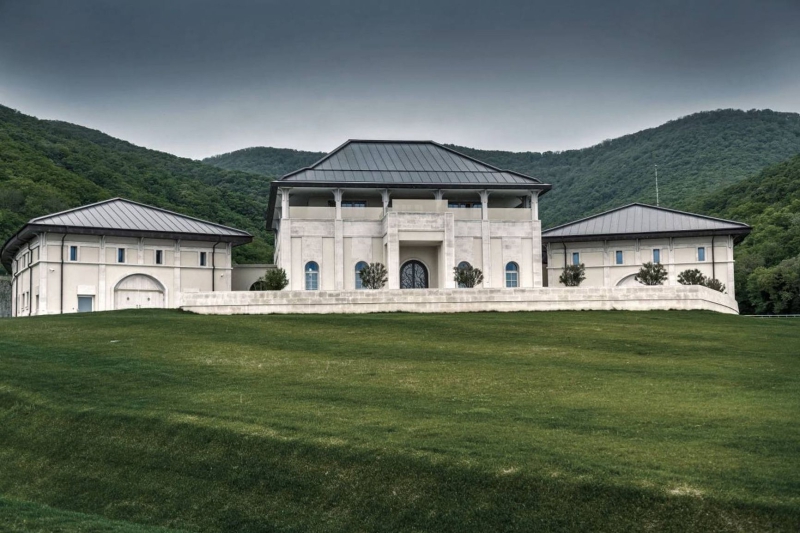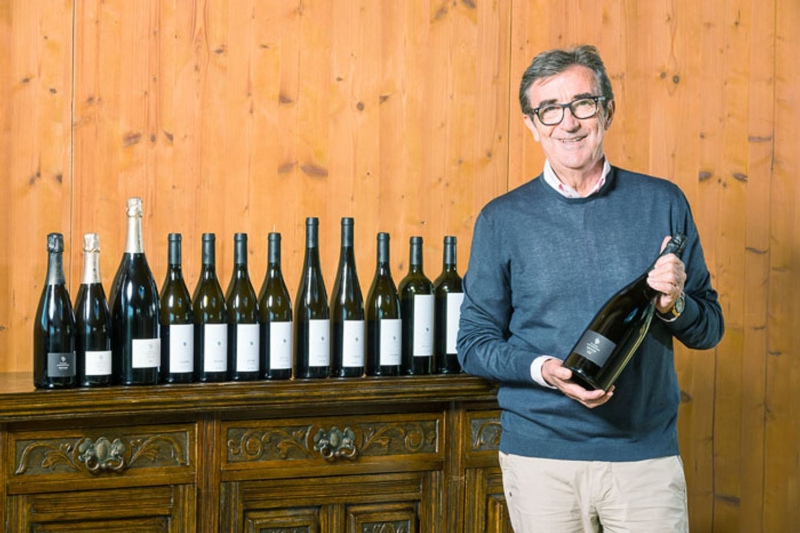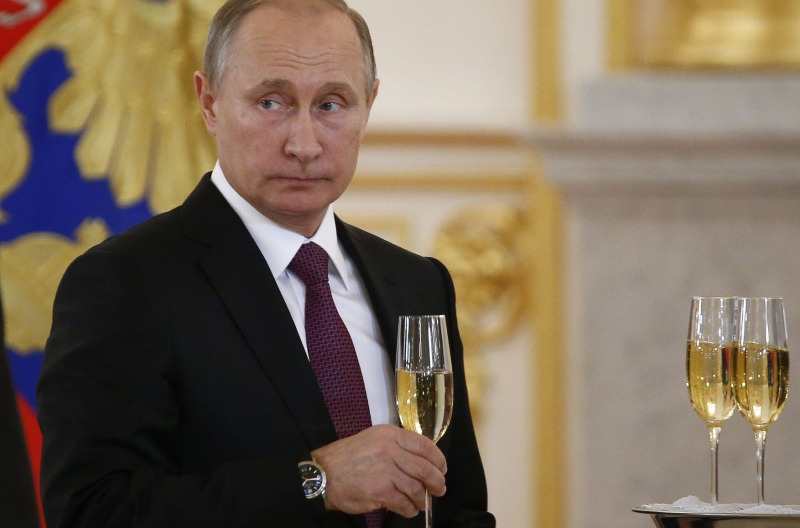The failed lunar mission conducted by Roscosmos cost the budget no less than 12 billion rubles ($124 million). However, this is much lower than what Vladimir Putin spends on his winemaking hobby, a cost that is also borne by the Russian populace. According to the Federal Tax Service, the combined assets of the two wineries near the palace in Gelendzhik are valued at 17 billion rubles ($176 million). To put this in perspective, the nearby wineries owned by Roman Abramovich, where no expense was spared on equipment, have assets worth less than half a billion rubles ($5.2 million). Despite Putin’s wines being showcased at official events and the production being overseen by a stellar cast of global wine industry experts, the losses incurred by companies managing the vineyards around the palace are on par with the annual budget of nearby Gelendzhik.
Millions of viewers remember the vineyard known as Krinitsa from the video called A Palace for Putin thanks to its Italian toilet brushes costing €700 and toilet paper holders priced at €1,038. In the video produced by the ACF, the vineyard was mentioned under the lengthy name “Vinicultural Estate 'Old Provence'.” Following the publication of the investigation, the enterprise changed its name to Krinitsa, after the nearby village.

In close proximity to Putin's palace, there are two vineyards. The first was established in 2009 and is called Divnomorskoye Estate. It was already well-known in the press, partly due to government banquets and receptions in the Kremlin. The second vineyard was established seven years later. According to information on Krinitsa's social media pages, grapevines were planted in 2016, and at the time of filming the video about the palace, the building was still under construction.
These two projects not only differ in their locations on opposite sides of the palace but also in their stylistic orientations. Divnomorskoye is clearly influenced by Italy: its chief oenologist is Italian Matteo Colletti, and until 2021, another Italian, Ricardo Cotarella, served as an external consultant. The grapevines were imported from an Italian nursery. In contrast, the later-established Krinitsa was designed in a French manner. The chief oenologist for this project is Frenchman Alexandre Muruzi. On 48.5 hectares of vineyards, grapevines from French nurseries grow, grapes are pressed in a French pneumatic press, Bucher Vaslin BVWL 18, wine fermentation occurs in French stainless steel isothermal fermenters from Serap and oak barrels from Seguin Moreau, and the finished wine is bottled on a French production line from Costral.
The equipment for Krinitsa was procured on a truly presidential scale. The vineyard exceeded all Russian enterprises in the number of suppliers of oak barrels, working with nine cooperages from Germany and France: Berthomieu, Cadus, Damy, Ermitage, Fassbinderei Stockinger, Saury, Seguin Moreau, and Taransaud. On the Krinitsa Instagram page, you can see the aging workshop with two and a half thousand barrels ranging from 225 to 500 liters. The winery's total floor area is 13,762.8 square meters. In 2022, it employed 99 people, several times more than enterprises of a similar scale. The distributor's price of Krinitsa wines ranges from 1629 to 3472 rubles ($17-$36) per bottle. In the context of Russian winemaking (taking into account the occupied Crimea), this falls into the premium segment, but it is not considered luxury, as wines from Pavel Shvets or Oleg Repin cost two to three times more.
According to a post on the Telegram channel Drunk Master, Alexandre Muruzi, Krinitsa oenologist, is a descendant of a Russian noble family, the Muruzis, who emigrated to France after the revolution. However, more intriguing is another Frenchman who played a crucial role in Alexandre's involvement with the project. This is David Pernet, the director of the consulting firm Sovivins. This small company based in Bordeaux offers a wide range of services to wineries worldwide, from soil analysis before planting vines to actual wine production. David is a recognized expert, and his opinions are quoted in specialized media when assessing the potential of new harvests in Bordeaux. On David's LinkedIn page, it is mentioned that he works on projects in France, Spain, the UK, the USA, Lebanon… and in Russia. David read the inquiry about the current status of his work on the Gelendzhik project but left it unanswered. In a February post on the Krinitsa Telegram channel, David was referred to as the current consultant for the project.
While Krinitsa collaborates with simply a renowned specialist, then Divnomorskoye can boast working with one of the stars of the global winemaking world. Ricardo Cotarella heads the Italian winemakers' association, Assoenologi. Together with his brother Renzo, he produces wine under the Familia Cotarella brand and advises dozens of projects in Italy and around the world. The most famous partners of the Cotarella brothers are the Antinori marquises, who own the eponymous wine brand.

Although the Divnomorskoye website still mentions Ricardo Cotarella as a consultant for the project, their collaboration with the renowned oenologist ended in August 2021. The Insider possesses a letter confirming the termination of the contract. However, Ricardo continued to work with three other wineries linked to the Russian elite. The Cotarella firm collaborated with the Tuscan winery Dodici, co-owned by propagandist Nikita Mikhalkov and his business partner Konstantin Tuvykin. In a comment to The Insider, Mr. Cotarella emphasized that the cooperation with Dodici was terminated in January 2023.
It is likely that former consultant Ricardo Cotarella continues to provide services to Andrey Yakunin, the son of the former head of Russian Railways, Vladimir Yakunin. Umbria24.it detailed the aspects of this large-scale project: a luxurious resort with 70 rooms, 79 villas, and a golf course is planned on 560 hectares around the historic Antognolla Castle in Umbria. Two hectares are designated for vineyards, and Ricardo Cotarella is mentioned as the chief oenologist for the project. Other documents also confirm Andrey Yakunin's ties to Antognolla S.P.A. Andrey Yakunin is a member of the board of directors of this company, and the investments of €150 million came from the VIY Greater Europe Hospitality fund, of which Yakunin Jr. is a board member.
In October 2022, Norwegian police arrested Andrey Yakunin for operating a drone within the country's territory, but he was acquitted and released from custody two months later. However, the Supreme Court later overturned the acquittal, but the son of the “Lake Cooperative” member did not return to be arrested once again.
Currently, Ricardo continues to advise the winery La Madonnina, owned by oligarch Konstantin Nikolaev. This is an ultra-premium project even by global standards. Its vineyards are located in Bolgheri, one of the most expensive subzones in Tuscany, adjacent to iconic wineries Ornellaia and Le Macchiole. The price of land per hectare here ranges from €200,000 to €400,000: the purchase of land alone was supposed to cost €10-€20 million.
In 2017, The New York Times published an investigation into Nikolaev's collaboration with the FSB in the development of night vision devices and the sponsorship of arrested Russian spy Maria Butina in the United States. In addition to thermal imagers, Nikolaev is directly involved in weapon production. In 2010, he became a co-owner of LLC Promtehnologiya, which produces Orsis sniper rifles. The promotion of his business interests was facilitated by the fact that Alexey Rogozin, the nephew of Dmitry Rogozin, who oversaw the Russian defense industry, served as the deputy general director of the company. The promotion has been quite successful: Orsis rifles have been adopted by the FSO and the National Guard of Russia, and in October 2022, they underwent testing for supplies to the Ministry of Defense. In July 2023, Scanner Project confirmed that the Nikolaev family is still involved in the production of weapons, some of which are used in the war against Ukraine. However, despite supplying weapons to Russian security forces and sponsoring a Russian spy, Nikolaev has avoided being included in sanction lists. The only country that has imposed sanctions on the Russian oligarch is Ukraine.
Ricardo Cotarella stated in an oral interview that he has not been working with the winery at Putin's palace in Gelendzhik since 2021, and his current Russian clients have not been subject to sanctions. Mr. Cotarella also mentioned that he has created a project to assist Ukrainian refugees in Italy, but no independent confirmation of this information from open sources or on the Cotarella Foundation website proved to be possible.
Five legal entities are associated with the palace winemaking business: AO Axis Investments, AO Apex Yug, AO Divnomorye, AO Moyo Vino, and OOO Lazurnaya Yagoda. For instance, AO Divnomorye produces wine under the “Divnomorskoye” brand, AO Axis Investments produces Krinitsa wine, and AO Moyo Vino is a managing company without its own assets.
The Insider analyzed the financial statements and explanations of the balance sheets of these five companies to estimate the overall cost of Vladimir Putin's winemaking hobby. The resulting data are summarized in the table below.

The fixed assets in the table above include tangible assets used for the production and sale of goods, the performance of work, and the provision of services. For example, in the case of Krinitsa (AO Axis Investments), the 8.386 billion rubles ($85.7 million) are attributable to buildings and structures (6.834 billion rubles, or $69.9 million), leased fixed assets (0.493 billion, or $5 million), and machinery, equipment, and inventory (1.058 billion rubles, or $10,8 million). Due to the requirements of the Russian Federal Service for the Regulation of the Alcohol Market, the fixed assets cannot directly include winemaking equipment. Therefore, in addition to the assets listed in the table, one should add two and a half thousand barrels from the best French coopers, fermenters, and French pneumatic presses. The cost of equipment for Krinitsa alone, according to a minimum estimate, is at least three million euros.
Additionally, the wineries received loans totaling tens of billions of rubles. The total amount of borrowed funds is 31.027 billion rubles ($317.4 million). As a result, it can be reasonably concluded that the total value of the assets owned by the wineries is 16.579 billion rubles ($169.6 million), and the cumulative losses they have incurred over their operation amount to 5.076 billion rubles ($51.9 million).
According to Ilya Shumanov, the director of Transparency International Russia, the financial statements of these companies demonstrate planned losses and do not resemble a successful commercial enterprise aimed at making a profit.
According to the official reports released on the Federal Tax Service website, the losses shown by the two wineries close to Putin's palace are just a bit less than the 2022 annual budget of the nearby resort town of Gelendzhik.
The losses incurred by the two wineries associated with Putin's palace exceed the budget of the city of Gelendzhik by 30%
To better assess the scale of Putin's wine hobby, the presidential winery can be compared to a similar project of another wealthy individual, Roman Abramovich. His winery, Gai Kodzor, is located near Putin's, in the vicinity of Gelendzhik. In 2021, it made it to the top 100 tourist friendly wineries according to World's Best Vineyards list compiled by Britain's William Reed, ranking 80th. The high-tech building and the involvement of French specialists in everything, from soil analysis to winemaking, indicate that no expenses were spared on this project. The Gai Kodzor vineyards span 89 hectares, an area slightly larger than the combined area of Divnomorskoye and Krinitsa. According to estimates, the fixed assets of OOO Gai Kodzor Vineyards and OOO Chateau Gai Kodzor are worth 248.7 million ($2.5 million) and 143.7 million rubles ($1.5 million), respectively. According to a formal evaluation based on financial statements, it would have been possible to build forty-two ultra-modern world-class wineries instead of two royal ones with “golden” toilet brushes.
Billion-ruble losses look even more astonishing against the backdrop of extensive state-sponsored promotion for Putin's wines. One of the most closed events at the St. Petersburg International Economic Forum (SPIEF) 2023 was a tasting of Divnomorskoye wines in a special carriage of a Sapsan high-speed train. As reported by the channel “SPIEF Inside,” twenty top executives of major corporations and media holdings spent four hours tasting 11 wines from Divnomorskoye Estate along with oysters, sea urchins, and scallops from the Bluefin restaurant. The tasting was conducted by the project's oenologist, Matteo Colletti.
This summer, the wines from the royal wineries were added to the menu of the country's largest airline. On July 21, Aeroflot announced a new wine menu for business class, including “Arena” from Krinitsa and “Yuzhny Les,” “Kholodny Tuman,” and “Solnechny Veter” from Divnomorskoye Estate.
Divnomorskoye Estate wines are served at government events, from the visit of Xi Jinping to the banquet with Kim Jong Un in Vladivostok. The recognizable logo with a seashell on the bottle's neck could be seen in photos of the basket of sausages that Igor Sechin had handed over “from Ivanych” to Minister Ulyukaev before the latter's arrest. Apparently, the bottle from the royal winery was supposed to symbolize Putin's direct involvement in the gift.
For a wider audience, the presidential wines are advertised on television. On July 4, 2022, REN TV aired a five-minute report that effectively served as a promotional video. Throughout the report, Dmitry Kiselyov interviewed employees of Krinitsa and Divnomorskoye, while also talking about European wines allegedly saturated with Russophobia and sulfates.
During 2022, the wine bar selections at the St. Petersburg International Economic Forum (SPIEF) exclusively featured wineries linked to Putin: Divnomorskoye was accompanied by Inkerman and Novy Svet (both of which fall under the management of JSC «Moyo Vino»). The latter two are owned by Yuri Kovalchuk, a close associate of Putin often referred to as his financial facilitator. There have been rumors suggesting plans to establish the House of Russian Wine in the historic building at Nevsky Prospekt, 1, directly facing the Hermitage, with Divnomorskoye Estate as its primary resident. However, this anticipated grand opening has yet to take place.
The connection between Divnomorskoye and Vladimir Putin became even more apparent based on a new investigation after the release of Alexei Navalny's film about the palace in Gelendzhik. In 2021, journalists from OCCRP, Meduza, and Vazhnye Istorii uncovered a group of 80 companies whose owners and directors used email addresses of the LLCInvest.ru domain and whose website domains were registered on Moscow City Telephone Network's servers. These emails are used by the managers of Lazurnaya Yagoda, its formal owner, the NGO Development of Agrarian Initiatives, as well as the Igora ski resort and Vladimir Putin's residence in the Novgorod region.
Another confirmation of the connection between Divnomorskoye and Putin is the fact that Alina Kabaeva's cousin, Ekaterina Golovacheva, works at the winery. Agentstvo discovered that until 2018, Ekaterina was part of the board of Alina Kabaeva's charitable foundation and worked as her assistant while Kabayeva was a State Duma deputy. Starting in 2020, Ekaterina appeared on the lists of employees of AO Divnomorye and AO Axis Investitions.

